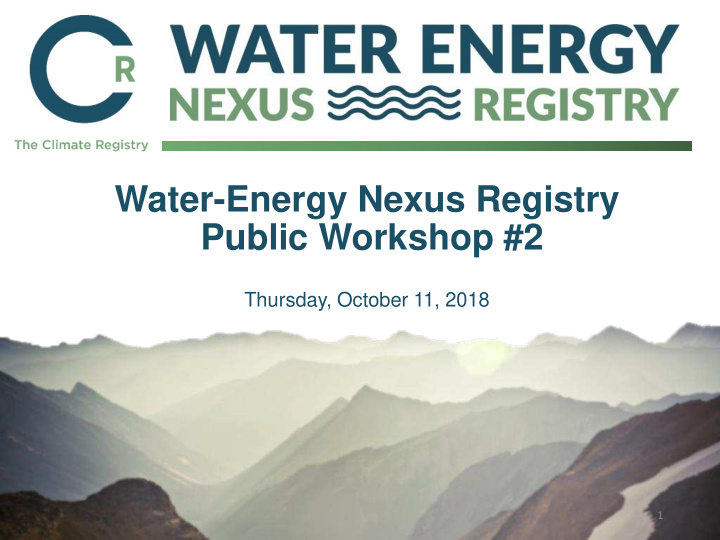



Water-Energy Nexus Registry Public Workshop #2 Thursday, October 11, 2018 1
Trivia Website Link: Kahoot.it 2
Training: GHG Reporting in in TCR’s Platform 3
Training Ryan Cassutt Manager, Voluntary Reporting Programs The Climate Registry 4
Carbon Footprint The total amount of greenhouse gases that are emitted into the atmosphere each year by an organization or company, either directly or indirectly. 5
Greenhouse Gases Carbon dioxide (CO 2 ) Methane (CH 4 ) Nitrous oxide (N 2 O) Hydrofluorocarbons (HFCs) Perfluorocarbons (PFCs) Sulfur hexafluoride (SF 6 ) Nitrogen trifluoride (NF 3 ) 6
Emissions Scopes Scope 1, 2, and 3 Graphic via Greenhouse Gas Protocol - https://ghgprotocol.org/ 7
Steps to the Reporting Process Identify your reporting boundaries Identify your facilities and sources Organize and collect data on emission sources Quantify and report emissions 8
Quantifying Emissions Once you have the data, how do you calculate emissions? Activity vity Data: : Emissi ssion n Factor : quantity of fuel or converts activity = X material that, when data into amount GHGs used, emits GHGs of GHGs e.g. 9.13 kg CO2 e.g. gallons of emitted per one gallon gasoline, SCF of of motor gasoline natural gas, Mwh of combusted electricity 9
Quantifying Scope 2 Emissions Scope 2 Accounting (Purchased Electricity, Steam, Heat or Cooling) Two accounting methods help clarify renewable energy claims and accounting: Location-based method Market-based method 10
Quantifying Scope 2 Emissions Location-Based Method Reflects emissions as they occur on the local grid Primarily uses grid- average emission factors I.e. emission factors reflecting emissions profile of power consumed in region Reflects overall fuel/generation mix of power in region 11
Quantifying Scope 2 Emissions Market-based Method Reflects the GHG emissions associated with choices you make about energy supply or purchase. Allows you to claim the specific emission rate associated with energy purchases Emission factors specific to renewable energy purchases: RECs, PPAs, etc. Utility-specific emission factors 12
Demonstration: Submitting Data in in CRIS IS 13
Overview Defining Facilities • Entering data • Submission Process • Running reports • Accessing public inventories • 14
CRIS Submission Workflow Submit Verification Positive TCR Draft Locked in Progress Verification Accepted Finding 15
GHG Reporting from a Water Agency Perspective Warren Teitz Team Manager, Resource Development Metropolitan Water District of Southern California 16
17
18
19
20
21
22
23
24
25
26
27
28
29
30
31
32
33
34
35
36
37
38
Trivia Website Link: Kahoot.it 39
Next Steps – Key Dates • November 29 : Working Group key issues call • January 2019 : Launch of public comment period • February 2019: Public comment period continues • April 2019 : In-person workshop #3 in Central California • May 2019: Program launch 40
Key Resources TCR’s Water -Energy Nexus Registry page • • Program overview • Current and upcoming workshop info (technical support documents on today’s key topics) • FAQs • Working Group members : • Technical Support Documents • Meeting notes, recordings and slide decks General Reporting Protocol Page • • Other GHG guidance available (Electric Power Sector Protocol, Local Government Operations Protocol, Transit Agency Metrics, etc.) • Default Emission Factors 41
Thank you! Meeting notes, recording, and slide deck will be available on the Water- Energy Nexus Registry page on TCR’s website: www.theclimateregistry.org/programs- services/California-water-energy-nexus-registry 42
Recommend
More recommend